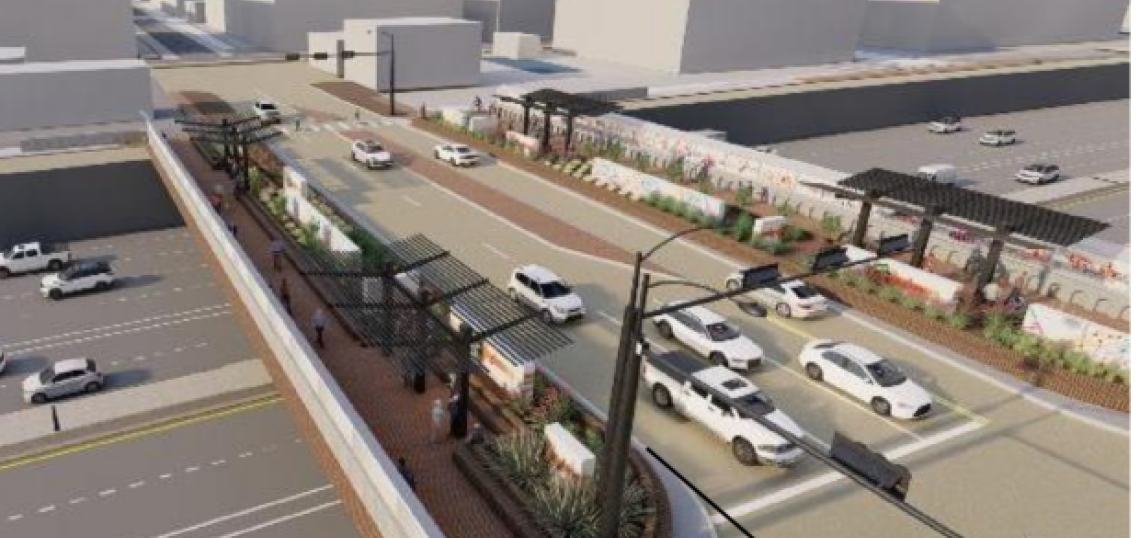City staff laid out scenarios and timelines for constructing a series of caps over portions of a reconstructed and lowered Interstate 35 for the City Council Tuesday work session. Council members heard a number of scenarios and timelines for adding caps, which are large plazas that would be built over portions of the sunken freeway that can support soil, trees, people, and buildings, the Austin Monitor reported.
The discussion is part of the city's contribution to the state of Texas' plan to expand I-35 through Austin.
The early consensus appears to be that the city wants to install eight caps through the downtown portions as well as north of the University of Texas up to 51st Street. The university has plans in the works for funding caps along its portion of the project.
The caps-only scenario would have the state providing basic 30-foot east-west “stitch” roadway crossings throughout the project, which would include wide sidewalks, bike lanes, seating and green space. The city would have until next year to adjust its plans and pay for four enhanced stitches to serve communities seen as needing improved east-west access across the interstate.
The total cost for the caps and enhanced stitches, with no funding set aside for amenities on top of the caps, is projected at $543 million. The city would need to provide the first $15 million of that cost by next month to cover early design work, with city budget staff planning a debt-backed budget amendment in the coming weeks to move forward with that payment.
Another $19 million for further design work would be due next December, at which time the city would also have to commit to a funding mechanism and plan to cover the roughly $500 million remaining.
In February, the city will learn if it will receive a Federal Transit Administration grant that would cover more than $100 million for the cap between Cesar Chavez and Fourth streets. Other possible funding sources for the basic cap infrastructure include a Transportation Infrastructure Finance and Innovation Act loan that could be repaid over 40 years. Staff also provided funding options for cap amenities projected at $336 million, including philanthropy, public/private partnerships and tax increment financing.
“For the infrastructure purposes, assuming $543 million, we could look at a capital stack of federal grants, TIFIA and bond election to cover those costs,” said Kim Olivares, deputy chief financial officer. “For cap amenities, that’s where you have your best opportunities for philanthropy and (public/private partnership) as well as the tax increment financing. … Those costs can vary significantly, specifically depending on what amenities you put on those caps.”
Mayor Kirk Watson, who has long been a proponent of the I-35 project since his time as a state senator, said the upcoming payment for early design work gives the city much of next year to evaluate the specific finished product, costs and financing options.
“Decision No. 1 is do we want to be prepared to take the first step, which is the $15 million with the understanding that that’s $15 million by the end of the year, that they would have to come back to us and probably have a reallocation of dollars. Then the second tranche would be an additional $19 million, but would have to be by the end of next year,” he said. “To the third, we have to be in a position to say, here’s what we’re going to do across the board.”
Council Member Alison Alter said the state’s early project schematics and designs including the caps and stitches suggested they would be making more of a commitment covering the cap costs.
Tucker Ferguson, the Texas Department of Transportation’s architect for the Austin district, said the early drafts included the caps because of the years of discussion in the city about the need for them from a community standpoint. But he acknowledged they weren’t part of the state’s portion of the project.
“I’m confused and a little bit frustrated because it seems like the caps are the thing that addressed some of the economic and environmental justice issues. They’re clearly not in the proposal that TxDOT’s coming to us with, at this point in time,” Alter said. “They were in all of the models that were shown to the community to get feedback. I think it is very clear that people in the community would be confused.”






